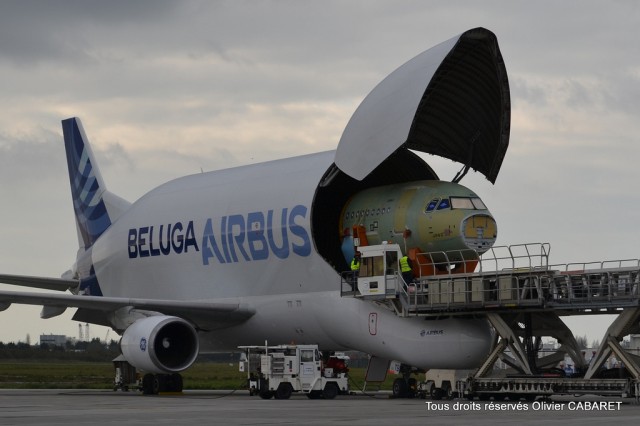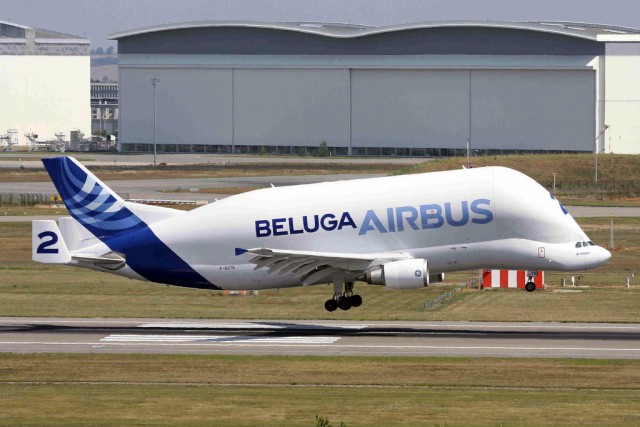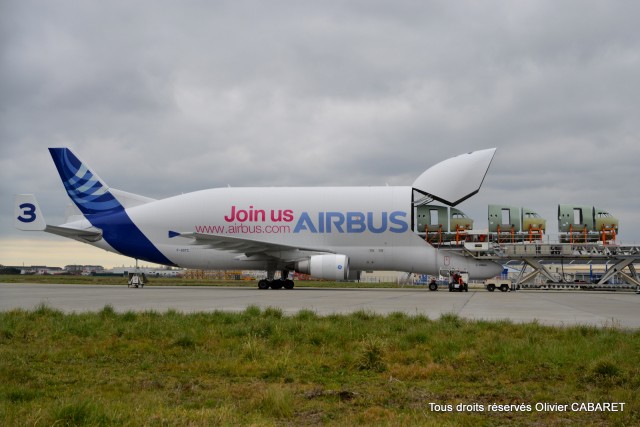
Out comes the nose section of an A320 aircraft from an Airbus A300-600 Beluga “Supertransporter” – Photo: Olivier CABARET | Flickr CC
This is an excerpt from Paul Thompson’s story on NYCAviation.com…
Throughout Airbus’ first two decades in business, its competitors at Boeing would joke that ’œEvery Airbus is delivered on the wings of a Boeing.’ That statement was both accurate and fair, being that Airbus had to use modified Boeing Stratocruisers known as Super Guppies. Yes, Airbus was transporting parts for its own jets inside 1940s-era planes built by its only real competitor.
As time progressed, Airbus finally resolved the issue by designing its own transport based on one of their own planes ’“ the A300 twin-engine jet.

A Beluga in the air looks almost like a Beluga whale out of water – Photo: Ken Fielding
The resulting A300-600ST (ST for Super Transporter) became commonly known as ’œThe Beluga’ for its bubble-like forehead resembling the Beluga whale. To accomplish the plane that seems to defy every law of aerodynamics, Airbus employed some major structural changes.
BONUS: Super Guppy Delivers Space Shuttle Trainer to the Museum of Flight
Starting at the nose, Airbus lowered the cockpit below the cargo deck so that the cargo area could be loaded without having to disconnect any of the vital electric and hydraulic lines running to the rest of the plane. The design kept the A300’s lower fuselage, wings and landing gears, but added a cavernous cargo area on top.

A320 noses are unloaded from the Beluga – Photo: Olivier CABARET | Flickr CC
At 49,440 cubic feet, the Beluga’s cargo volume ranks second between Boeing’s 747-LCF Dreamlifter (65,000 cubic feet) and the Antonov An-225 (45,909 cubic feet). The Beluga is hampered by its weight lifting capability, which is only 47 tons (103,617 pounds) or roughly the weight of an empty 737. Its cargo bay measures 25 feet in diameter. The Beluga has a maximum takeoff weight of just over 341,000 pounds, while the Dreamlifter tops out at 803,000 pounds.
BONUS: Antonov AN-225 Photo Tour
In comparison, the 747-8 freighter is capable of lifting over one million pounds, and the An-225 can lift over 1.4 million pounds. The Beluga is also incapable of hauling sections of the A380 due to its size. Those parts are still taken by barge or road convoy to the A380’s final assembly location in Toulouse.
Continue reading On the Wings of Giants: Airbus Banks on the Beluga on NYCAviation.com
Comments are closed here.
Airbus are looking into replacing the Beluga with a much larger aircraft. My guess would be a A380 . But the Beluga is still a amazing looking aircraft. I have seen a dreamlifter at Paine field when I was there in July also a very cool looking aircraft.
They are actually working on designing a replacement for the A300-608ST based on the A330-200. The A300ST fleet is now 19/20 years old and they aim to start replacing them with new build A330ST’s around 2020
Thanks Ken I had a feeling it was wrong about the A380.
Thanks for sharing the OTHER story. LMAO with mention of the Guppie. Make no mistake! Ofer 80+ year, TBC has stumbled as few times, but how always survives – and wins, BAC, or the start-ups? Guppies, the whatever or the Boeing Dream Lifter, bothe beeing and the Frechies can and will build whatever is necessary to move their parts. If either one needs, they will build it or hire it on the limited market.
So what is with that other company? Lazy pilots and PNFs just love them. OTOH. most pilots with real skills still wear the “If its not a Boeing – I’m not going,” cap. darn good reasons.
I’m surprised to see this from BAC’s home town, but fair is fair! The AB company makes very good airplanes, perhaps specially suited for pilots who may understand computer rules, but have low time and very little experience. That won’t usually fly in Amerika, but for the rest of the world… just see the numbers.
I do not work for Boeing and I never have. Four earlier generations of my family did, including one who truly was ‘shat upon.’ If indirectly, Boeing paid for my education and that of many relatives. I pick my flights on hardware, period. -C.